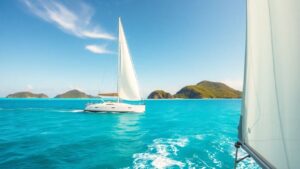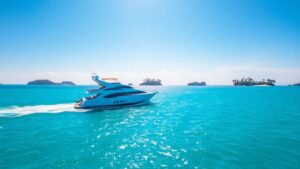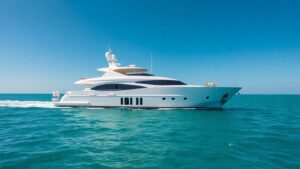Thinking about casting a line in the British Virgin Islands? It’s a pretty sweet spot for fishing, honestly. You’ve got everything from shallow flats perfect for bonefish to deep offshore drops teeming with marlin. Whether you’re a total beginner or you’ve been fishing for years, the BVI has something to offer. This guide is all about helping you get the most out of your BVI fishing trip, covering where to go, what to expect season-wise, and some tips to help you land that catch.
Key Takeaways
- The BVI offers diverse fishing grounds, from shallow inshore flats ideal for bonefish and tarpon to deep offshore drops known for marlin and tuna.
- Seasonal patterns influence fishing success; bonefish are best targeted in winter, while offshore species like marlin and tuna are more active in summer.
- Effective techniques include trolling for species like mahi-mahi and wahoo, bottom fishing near reefs and wrecks for snapper and grouper, and light-tackle or fly-fishing for inshore species.
- It’s important to be aware of BVI fishing regulations, including protected species like turtles and lobsters, and to practice catch-and-release for certain game fish.
- While charters often provide gear, packing appropriate clothing, polarized sunglasses, and sunscreen is key for comfort and safety during your BVI fishing adventure.
Prime BVI Fishing Locations
The British Virgin Islands are a real gem for anyone who loves to fish. The waters here are just teeming with life, offering a bit of everything for every kind of angler. Whether you’re looking to stalk bonefish on the flats or battle a big game fish offshore, you’ve come to the right place.
Inshore Hotspots for Bonefish and Tarpon
If you’re into the thrill of sight fishing in shallow waters, the BVI’s inshore areas are fantastic. The flats around Anegada are particularly famous for bonefish. These fish are a favorite for fly anglers because they really test your casting skills. You’ll find them in the clear, shallow water, so spotting them before they spot you is part of the fun. Tarpon, on the other hand, tend to hang out in areas with more cover, like mangrove edges and harbors, especially around Tortola. They’re known for their powerful runs and acrobatic leaps when hooked, making for an exciting fight.
- Anegada Flats: Prime territory for bonefish, especially during the cooler months.
- Tortola Mangroves & Harbors: Good spots to find tarpon.
- Techniques: Light-tackle and fly-fishing are the go-to methods here.
The shallow, clear waters demand stealth and accurate casting. Patience is key when stalking these elusive inshore species.
Offshore Adventures at the North and South Drops
For those who dream of battling larger game fish, the offshore waters of the BVI are where it’s at. The real action happens at the North Drop and South Drop. These are deep underwater ledges where currents bring in a lot of bait, attracting big pelagic species. Think blue marlin, yellowfin tuna, and sailfish. These spots are legendary among serious sport fishermen. Getting out to the drops usually means a longer boat ride, but the chance to hook into a world-class trophy fish makes it well worth the trip. It’s a different kind of fishing than the inshore stuff – more about covering water and finding where the big ones are feeding.
- North Drop & South Drop: Deep water areas known for big game fish.
- Target Species: Blue Marlin, Yellowfin Tuna, Sailfish.
- Best Approach: Trolling with lures or rigged baits is a common and effective method.
Reef and Wreck Fishing Near Virgin Gorda
If you prefer fishing closer to shore but still want a good fight, the reefs and wrecks around Virgin Gorda are excellent choices. These underwater structures act as homes for a variety of fish. You can expect to find snapper, grouper, and amberjack. Bottom fishing is the main technique here. You’ll be dropping lines down to the seabed, often using bait to entice these reef dwellers. It’s a great way to catch a good meal and enjoy some steady action. Plus, exploring these spots often means you’re fishing in beautiful, clear water with plenty to see.
| Target Species | Location Type | Common Techniques |
|---|---|---|
| Snapper & Grouper | Reefs & Wrecks | Bottom Fishing |
| Amberjack | Reefs & Wrecks | Bottom Fishing |
- Virgin Gorda Area: Offers numerous reefs and wrecks.
- Catch Potential: Snapper, Grouper, Amberjack.
- Method: Primarily bottom fishing with bait.
Seasonal Opportunities for BVI Anglers
The British Virgin Islands offer fantastic fishing throughout the year, but knowing the seasons can really help you target specific species and make the most of your trip. It’s not just about luck; it’s about timing your adventure right.
Winter Pursuits: Bonefish on the Flats
From November through February, the shallow flats of the BVI become prime territory for bonefish. These elusive fish are a favorite among fly anglers. The clear, calm waters allow for sight fishing, where you can spot the fish before casting. It’s a real test of skill and patience. You’ll want to focus on areas like the flats around Anegada, where these fish love to feed on crustaceans and small baitfish. Early mornings and late afternoons are often the best times to find them actively feeding.
- Best Time: November to February
- Target Species: Bonefish
- Key Locations: Flats around Anegada
- Techniques: Fly fishing, light tackle, sight fishing
The thrill of spotting a bonefish tailing in the shallows and making that perfect cast is an experience unlike any other. It requires a delicate touch and a keen eye.
Summer Chases: Marlin and Tuna Offshore
When summer rolls around, typically from June to September, the deeper offshore waters come alive. This is when the big game action heats up, especially for blue marlin and yellowfin tuna. The famous North and South Drops are the places to be. These areas are underwater canyons that attract a lot of bait, which in turn draws in the larger predatory fish. Trolling with artificial lures or rigged ballyhoo is a common and effective method here. It’s a different kind of fishing than the flats, requiring heavier gear and a lot of endurance, but the rewards can be spectacular. Many anglers consider Jost van Dyke a top spot for these summer offshore pursuits. Jost van Dyke’s waters are known for monster Atlantic Blue Marlin during these months.
| Species | Best Season | Key Locations |
|---|---|---|
| Blue Marlin | June-Sept | North & South Drops |
| Yellowfin Tuna | June-Sept | North & South Drops |
| Mahi-Mahi | Year-round | Nearshore Reefs |
Remember, offshore fishing can be demanding, so be prepared for longer runs and potentially rougher seas. It’s all part of the adventure when chasing these powerful game fish.
Effective Fishing Techniques in the BVI

Fishing in the BVI is all about picking the right method for the fish you’re after. It’s not just about casting a line; it’s a bit of an art, really.
Mastering the Art of Trolling
Trolling is a super popular way to fish here, especially if you’re looking for speedsters like mahi-mahi and wahoo. You basically drag lures or bait through the water while your boat is moving. It covers a lot of ground and really gets the attention of fish that like to chase. Think about running your lines at different depths and distances from the boat to see what works best. It’s a great way to cover more water and find active fish, especially around the islands and reefs.
- Lure Selection: Bright, flashy lures often work well for mahi-mahi, while more natural baitfish patterns can attract wahoo.
- Speed: Experiment with different trolling speeds; faster can work for wahoo, while slower might be better for other species.
- Depth: Use downriggers or planers to get your bait into the strike zone where fish might be holding.
Trolling is a fantastic method for covering a lot of water and finding active fish, especially when you’re not sure exactly where they are holding. It’s a bit like a treasure hunt, but with fishing rods.
The Thrill of Bottom Fishing
If you prefer to target fish that hang out near the seabed, bottom fishing is your go-to. You’ll want to find reefs or wrecks, as these spots are like underwater cities, attracting all sorts of fish looking for food and shelter. Species like snapper and grouper love these areas. You’ll typically use heavier tackle for this, dropping your bait right down to where the fish are.
- Bait: Fresh cut bait or squid are usually a hit with bottom dwellers.
- Rigging: A simple fish-finder rig or a two-hook bottom rig works well.
- Location: Look for structure like reefs, wrecks, or drop-offs on your fishfinder.
Light-Tackle and Fly-Fishing for Inshore Species
For the inshore crowd, especially bonefish and tarpon, light-tackle and fly-fishing are where it’s at. This is all about precision and presentation. You’re often fishing in shallow, clear water, so stealth is key. You want to present your fly or lure in a way that looks natural, fooling the fish into biting. It’s a real test of skill and patience, but the reward of seeing a fish take your offering is pretty amazing.
- Bonefish: These guys are spooky, so long leaders and accurate casts are important. Small shrimp imitations or crab flies are good choices.
- Tarpon: Tarpon are powerful fighters. Use strong leaders and be ready for explosive takes. Larger baitfish or shrimp patterns work well.
- Stealth: Approach flats quietly, avoid casting shadows over the fish, and make your first cast count.
Understanding BVI Fishing Regulations

Before you even think about casting a line in the British Virgin Islands, it’s super important to get your head around the local rules. It’s not just about having fun; it’s about keeping the waters healthy for everyone, now and later.
Navigating Protected Species and Catch-and-Release
Some of the coolest creatures you might see aren’t on the menu. Things like turtles and lobsters are totally off-limits, and there are some hefty fines if you get caught with them. It’s a good idea to know what they look like before you go. Also, for the big game fish like marlin, the general vibe is catch-and-release. It really helps keep these amazing fish populations strong. So, if you hook a big one, take a quick photo and let it swim away healthy.
Essential Licensing Information for Anglers
To fish legally in the BVI, you’ll need a fishing license. You can get a 30-day license by applying to the Department of Conservation & Fisheries. You’ll need to provide a form of ID, like your passport or driver’s license, and pay the fee. It’s best to apply at least two weeks before your trip because it can take up to 10 business days to process. Don’t wait until the last minute!
Identifying Safe vs. Potentially Poisonous Catches
Not all fish are safe to eat, and some can make you pretty sick if you’re not careful. For instance, triggerfish come in a few varieties. The black triggerfish is poisonous, so steer clear. Dark triggerfish are okay for commercial use, but the yellow ones are rare and should be released. Barracuda can also be risky, so it’s generally recommended to release them. Lionfish, though not native, are actually good to catch and help the local environment, so feel free to reel those in. Always double-check with local guides or resources if you’re unsure about a catch.
Knowing the rules and respecting the marine life is part of what makes fishing in the BVI such a great experience. It’s all about balance – enjoying the sport while making sure the beautiful waters stay that way.
Essential Gear and Charter Services
Getting your fishing trip in the BVI set up right means thinking about what you’ll need to bring and how you’ll get out on the water. Most fishing charters will have rods and reels covered, but you’ll want to pack some personal items to make sure you’re comfortable and protected from the sun. Think lightweight, long-sleeved shirts and pants made of breathable material. They’ll keep you cool and block out those strong rays. Don’t forget polarized sunglasses; they really help cut down the glare on the water so you can actually see what’s going on beneath the surface. A wide-brimmed hat is also a good idea for extra face and neck protection. And for your feet? Non-slip, waterproof shoes or sandals are best for staying steady on a boat deck. Oh, and plenty of high-SPF sunscreen and lip balm, because that sun is no joke.
What to Pack for a Day on the Water
- Clothing: Lightweight, long-sleeved shirts and pants for sun protection.
- Eyewear: Polarized sunglasses to reduce glare and spot fish.
- Headwear: A wide-brimmed hat for face and neck shade.
- Footwear: Water-resistant, non-slip shoes or sandals.
- Sun Protection: High-SPF sunscreen and lip balm.
It’s a good idea to pack a small, waterproof bag for your personal items like your phone, keys, and any snacks. Staying hydrated is also super important, so bring a reusable water bottle.
Leveraging Local Fishing Charters and Equipment
Booking a fishing charter is a fantastic way to experience the best fishing spots in the BVI, especially if you’re not familiar with the area or don’t have your own gear. Local captains know these waters like the back of their hand and can guide you to where the fish are biting. They often have half-day or full-day trips available, and some can even arrange multi-day excursions. Many charter services also provide fishing equipment, so you don’t have to worry about bringing your own rods and reels. Some yacht charter companies even let you pre-order fishing packages that come with all the necessary gear, making it super convenient to start fishing right from your boat. It really takes the hassle out of planning and lets you focus on the fun part – catching fish!
Wrapping Up Your BVI Fishing Adventure
So, you’ve got the lowdown on where to cast your line and what techniques to try in the beautiful British Virgin Islands. From the shallow flats teeming with bonefish near Anegada to the deep offshore drops where marlin and tuna hang out, there’s a spot for every angler. Remember to check the regulations, especially about protected species, and consider a charter if you want to make things easy. Whether you’re a beginner or a pro, the BVI waters offer a fantastic fishing experience. Get out there and enjoy the thrill of the catch!
Frequently Asked Questions
When is the best time to go fishing in the BVI?
The best times to fish in the BVI depend on what you want to catch. For bonefish in shallow waters, winter (November to February) is excellent. If you’re dreaming of catching big game fish like marlin and tuna offshore, the warmer months from June to September are your best bet.
Where are the best places to fish in the BVI?
You can find great fishing spots all around the islands. For bonefish, the shallow flats near Anegada are amazing. Tarpon often hang out in mangrove areas and harbors, especially near Tortola. For bigger offshore fish like marlin, you’ll want to try the famous North and South Drops.
Do I need a license to fish in the British Virgin Islands?
Yes, you’ll need a fishing license to fish in the BVI. You can apply for a 30-day license through the Department of Conservation & Fisheries. It’s a good idea to apply at least two weeks before your trip because it can take about 10 business days to process.
Are there any rules about what fish I can catch or keep?
It’s important to know the rules! Some fish, like turtles and lobsters, are protected and you absolutely cannot catch them. For big game fish like marlin, it’s best to release them after catching to help protect the population. Also, be aware that some fish, like certain triggerfish and barracuda, can be poisonous, so it’s smart to check before you eat anything.
What should I bring with me if I go on a fishing trip?
Most fishing charters provide the gear you need. However, it’s smart to bring your own essentials like polarized sunglasses to cut glare, a wide-brimmed hat for sun protection, sunscreen, and comfortable, lightweight clothing that protects you from the sun. Non-slip shoes are also a good idea for the boat.
Are there fishing charter services available, and do they provide equipment?
Using a fishing charter is a fantastic way to fish in the BVI. Local captains know the best spots and techniques. Many charters also offer equipment rentals, so you don’t have to worry if you didn’t bring your own gear. You can even arrange to have fishing packages delivered to your yacht!



